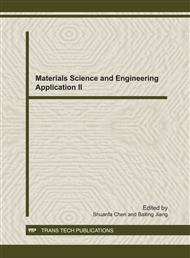[1]
N.C. Brown, Forest products, their manufacture and use(J. Wiley New York 1919).
Google Scholar
[2]
C.E. Byrne, D.C. Nagle, Cellulose derived composites – A new method for materials processing, Mater. Res. Innovations Vol. 1 (1997), pp.137-144.
DOI: 10.1007/s100190050031
Google Scholar
[3]
C.E. Byrne, D.C. Nagle, Carbonization of wood for advanced materials applications, Carbon Vol. 35 (1997), pp.259-266.
DOI: 10.1016/s0008-6223(96)00136-4
Google Scholar
[4]
C.E. Byrne, D.C. Nagle, Carbonized wood monoliths-Characterization, Carbon Vol. 35 (1997) pp.267-273.
DOI: 10.1016/s0008-6223(96)00135-2
Google Scholar
[5]
S. -M. Kwon, N. -H. Kim, D. -S. Cha, An investigation on the transition characteristics of the wood cell walls during carbonization, Wood Sci. Technol. Vol. 43 (2009), pp.487-498.
DOI: 10.1007/s00226-009-0245-6
Google Scholar
[6]
D. Özçimen, A. Ersoy-Meriçboyu, A study on the carbonization of grapeseed and chestnut shell, Fuel Process. Technol. Vol. 89 (2008), pp.1041-1046.
DOI: 10.1016/j.fuproc.2008.04.006
Google Scholar
[7]
P. Gao, M. Wu, B. Li, Y. Liu, Structure characterization and oxidation mechanism study of porous biomorphic carbon template derived from basswood, Mater. Res. Bull. Vol. 44 (2009), pp.644-648.
DOI: 10.1016/j.materresbull.2008.06.025
Google Scholar
[8]
O. Paris, C. Zollfrank, G.A. Zickler, Decomposition and carbonisation of wood biopolymers-a microstructural study of softwood pyrolysis, Carbon Vol. 43 (2005), pp.53-66.
DOI: 10.1016/j.carbon.2004.08.034
Google Scholar
[9]
Y. -R. Rhim, D. Zhang, M. Rooney, D.C. Nagle, D.H. Fairbrother, C. Herman, D.G. Drewry Iii, Changes in the thermophysical properties of microcrystalline cellulose as function of carbonization temperature, Carbon Vol. 48 (2010), pp.31-40.
DOI: 10.1016/j.carbon.2009.07.048
Google Scholar
[10]
C.S.M. Turney, D. Wheeler, A.R. Chivas, Carbon isotope fractionation in wood during carbonization, Geochim. Cosmochim. Acta Vol. 70 (2006), pp.960-964.
DOI: 10.1016/j.gca.2005.10.031
Google Scholar
[11]
K. Ishimaru, T. Hata, P. Bronsveld, Y. Imamura, Microstructural study of carbonized wood after cell wall sectioning, J. Mater. Sci. Vol. 42 (2007), pp.2662-2668.
DOI: 10.1007/s10853-006-1361-4
Google Scholar
[12]
T. -C. Wang, T. -X. Fan, D. Zhang, G. -D. Zhang, The fabrication and wear properties of C/Al and (C + SiC)/Al composites based on wood template, Mater. Lett. Vol. 60 (2006), pp.2695-2699.
DOI: 10.1016/j.matlet.2006.01.074
Google Scholar
[13]
T. -C. Wang, T. -X. Fan, D. Zhang, G. -D. Zhang, Fabrication and the wear behaviors of the carbon/aluminum composites based on wood templates, Carbon Vol. 44 (2006), pp.900-906.
DOI: 10.1016/j.carbon.2005.10.022
Google Scholar
[14]
G. Kranthi, A. Satapathy, Evaluation and prediction of wear response of pine wood dust filled epoxy composites using neural computation, Comput. Mater. Sci. Vol. 49(2010), pp.609-614.
DOI: 10.1016/j.commatsci.2010.06.001
Google Scholar
[15]
M. Vasudevan, B.P.C. Rao, B. Venkatraman, T. Jayakumar, B. Raj, Artificial neural network modelling for evaluating austenitic stainless steel and Zircaloy-2 welds, J. Mater. Process. Technol. Vol. 169 (2005), pp.396-400.
DOI: 10.1016/j.jmatprotec.2005.04.081
Google Scholar
[16]
D.H. Wu, M.S. Chang, Use of Taguchi method to develop a robust design for the magnesium alloy die casting process, Mater. Sci. Eng., A Vol. 379 (2004), pp.366-371.
DOI: 10.1016/j.msea.2004.03.006
Google Scholar
[17]
W. Sha, K.L. Edwards, The use of artificial neural networks in materials science based research, Mater. Des. Vol. 28 (2007), pp.1747-1752.
Google Scholar


